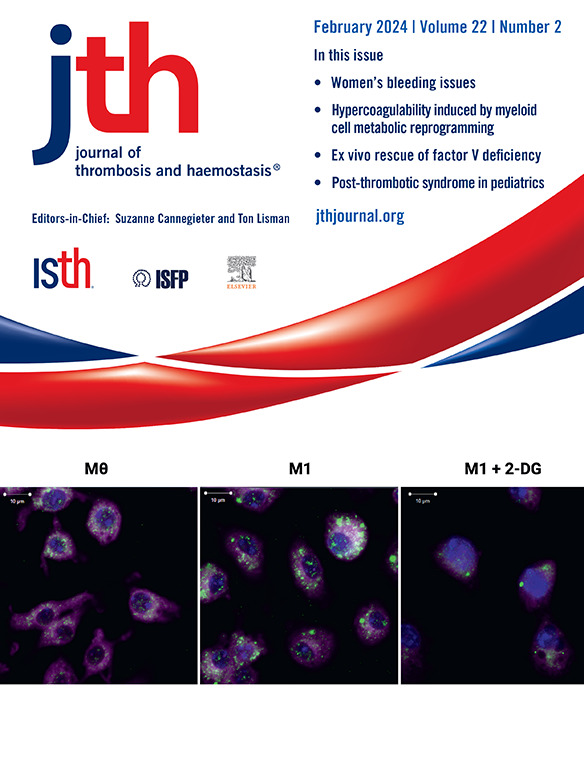Prolonged vs standard thromboprophylaxis in patients with esophageal cancer undergoing surgery: a randomized controlled study
IF 5.5
2区 医学
Q1 HEMATOLOGY
引用次数: 0
Abstract
Background
Recent guidelines recommend prolonged thromboprophylaxis after esophagectomy due to cancer. However, to our knowledge, no previous studies have examined if prolonged prophylaxis is superior to standard in-hospital prophylaxis.
Objectives
We aimed to perform the first clinical randomized study testing the efficacy of a prolonged 1-month thromboprophylaxis with low-molecular-weight heparin vs the standard treatment.
Methods
The study was an open-label, randomized, controlled trial including patients undergoing esophagectomy. The primary endpoint was the difference in prothrombin fragment 1 + 2 (F1 + 2) levels 1 month after surgery between the standard group and the intervention group. The secondary endpoints were the incidence of venous thromboembolic events and mortality.
Results
The study was terminated before reaching the expected sample size of 100 patients due to low accrual. We included 79 patients. At follow-up 1 month after surgery, F1 + 2 levels did not differ between the standard group and the intervention group (P = .41). Incidence of venous thrombosis was similar in the 2 groups, with 13% in the standard group and 15% in the intervention group. Preoperative F1 + 2 levels were significantly higher in patients who developed a venous thrombosis within 1 month after surgery than in those who did not (P = .01). The odds ratio of venous thromboembolism per 50 pmol/L increase in F1 + 2 was 1.64 (95% CI, 1.17-2.54). No patients died within 1 month after surgery.
Conclusion
No benefit of prolonged thromboprophylaxis after esophagectomy was found. Preoperative F1 + 2 levels were found to be a predictor for the incidence of postoperative thromboembolism.
求助全文
约1分钟内获得全文
求助全文
来源期刊
CiteScore
24.30
自引率
3.80%
发文量
321
审稿时长
1 months
期刊介绍:
The Journal of Thrombosis and Haemostasis (JTH) serves as the official journal of the International Society on Thrombosis and Haemostasis. It is dedicated to advancing science related to thrombosis, bleeding disorders, and vascular biology through the dissemination and exchange of information and ideas within the global research community.
Types of Publications:
The journal publishes a variety of content, including:
Original research reports
State-of-the-art reviews
Brief reports
Case reports
Invited commentaries on publications in the Journal
Forum articles
Correspondence
Announcements
Scope of Contributions:
Editors invite contributions from both fundamental and clinical domains. These include:
Basic manuscripts on blood coagulation and fibrinolysis
Studies on proteins and reactions related to thrombosis and haemostasis
Research on blood platelets and their interactions with other biological systems, such as the vessel wall, blood cells, and invading organisms
Clinical manuscripts covering various topics including venous thrombosis, arterial disease, hemophilia, bleeding disorders, and platelet diseases
Clinical manuscripts may encompass etiology, diagnostics, prognosis, prevention, and treatment strategies.

 求助内容:
求助内容: 应助结果提醒方式:
应助结果提醒方式:


